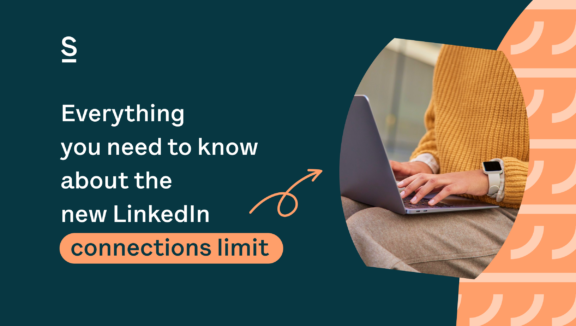Everything you need to know about LinkedIn’s connection limits

Here’s how to stay within the LinkedIn connections limit and still achieve prospecting success.
One of the main principles of using LinkedIn is to connect with others on a professional level. It’s different from many other social networks in that it doesn’t focus on mindless scrolling or likes; LinkedIn is about connecting professionally with others to form business relationships.
However, it is possible to connect with people on LinkedIn in different ways. LinkedIn wants to protect its users from spam and make sure people are connecting in the right ways, and that’s why the platform has limits when it comes to connections.
Read on to find out what these limits are, the best ways to work without abusing them, and how to maximize your LinkedIn connections for sales success.
The difference between LinkedIn’s 1st-degree, 2nd-degree, and 3rd-degree connections:
Before you can understand LinkedIn’s connection limits, it’s important to understand the varying types of LinkedIn connections themselves. LinkedIn has three types of connections: 1st-degree, 2nd-degree, and 3rd-degree.
1st-degree connections
These connections include people you’re most directly connected to because you’ve accepted an invitation from them or vice versa. If you search for a 1st-degree connection, you’ll see a 1st-degree icon next to their name, which will also appear in their profile. You can contact your 1st-degree connections by sending them LinkedIn messages.
2nd-degree connections
These connections are users connected to your 1st-degree connections. If you search for a 2nd-degree connection, you’ll see a 2nd-degree icon next to their name, which will also appear in their profile. If you want to contact a 2nd-degree connection, send them a request to connect with them. Or, you can send them an InMail message, but do note this is a premium feature not available to basic users.
3rd-degree connections
These connections are users connected to your 2nd-degree connections. If you search for a 3rd-degree connection, you’ll see a 3rd-degree icon next to their name, which will also appear in their profile. If you want to contact a 3rd-degree connection, send them a request to connect with them. Or, you can send them an InMail message, but do note this is a premium feature not available to basic users.
Out-of-network connections
These are the people outside of your network that don’t have any connections with you or any of your 1st-degree, 2nd-degree, or 3rd-degree connections. Send them a request to connect if you’d like to connect with them.
Members of your LinkedIn Groups
Members of the same LinkedIn group are considered part of your network. Connect with them by sending a message through your group.

Reach the right prospects with Surfe
Surfe enriches contact data to ensure your emails always reach the right person. You can even sync all of your messages to LinkedIn prospects with your CRM so your team is all on the same page!
What is LinkedIn’s connection limit?
Now that you’re clear on the different LinkedIn connections, it’s important to note the LinkedIn connection limit of 30,000 1st-degree connections. The limit was put in place to protect the overall member experience.
In fact, LinkedIn states,“ To ensure an optimal site experience, the network size limit for LinkedIn members is a maximum of 30,000 1st-degree connections. We recommend that you only keep quality connections in your network.”
But does the new connection limit actually make for an optimal site experience? We’ll dig in to analyze, so read on to find out.
What are LinkedIn’s weekly restrictions?
LinkedIn has also imposed a restriction of about 100 invites per week, or 20-25 per day. It’s worth noting that all LinkedIn members are subject to invitation limits and restrictions.
Can you (and should you) bypass these restrictions?
Sometimes, it is possible to bypass these restrictions. However, doing so is probably not a good idea because you’ll likely be flagged or banned. We’ll offer advice at the end of this article on how to slowly increase your limit without getting banned or flagged – but immediately jumping past restriction limits is not the best way to do it.
If you do need to bypass this restriction, sending InMail messages is the best way to do so, which is available to LinkedIn users with a premium account. Messaging those in your groups is the other way to circle around these restrictions.
That being said, these restrictions are put in place for a reason, and thinking about how you can best work within them is the best strategy versus figuring out how to circumvent them. But we’ll dig into this more end of the article.
What to do if you get flagged?
So you’ve bypassed the limits and are restricted from sending out invitations. Don’t panic.
Usually, most restrictions will be removed from your account within a week. But it is worth jumping back in a few hours later to see, especially if it’s your first restriction. If you’ve received multiple restrictions, try back in a few days.
And if you’ve been restricted for having a large number of outstanding invitations, it might take a full month for your account to be restriction-free once again, or for you to be able to send another invitation.
Do LinkedIn’s connections limit hurt or help salespeople?
If you’re worried about these new limits affecting your prospecting habits, it’s time to think about quantity vs. quality.
Perhaps before you were sending out more than 100 invites a week. How many of those prospects led you to deals? Now, perhaps you’re sending out 100, or maybe less. So, think of this as an opportunity to improve your acceptance rate and focus on the right prospects using more efficient methods of lead generation.
These prospects should be quality, well-researched connections that might actually want to buy what you’re selling. Think about connections not just as connections but as possible clients. What types of people do you really want or need to be connecting with? A strong selling process and outreach strategy (see below) will ensure you’re targeting the right prospects.
Not every connection will be funneled down the sales pipeline, but perhaps the ones that aren’t can lead you to prospects that will.
Make sure to truly connect with your connections. When making sales deals, increasing your follower count may not help you unless the connections are quality ones. Connect with those that add notable value to your network.
How to form the best outreach strategy and increase your daily limits
Creating an outreach strategy that works around LinkedIn’s connections limit is the best way to prospect without getting flagged or banned. We already discussed focusing on quality over quantity, and making sure to create personal intro messages for each person you’re contacting is important, too.
Remember, these aren’t just connections; they’re people who want to feel valued. So be professional, kind, and personalize your interactions and invitations whenever possible. When prospects feel valued, they’ll add value.
For example, using tech tools like Surfe, which connects your CRM with LinkedIn, can make it easier to contact and track quality connections. You’ll be able to focus on quality prospects because it’s easy to tell if a prospect has been contacted. And, all interactions with them will be saved to the CRM clearly and concisely so other coworkers can see it – and no one’s time is wasted. Using a tool like Sales Navigator can help you better target the right quality contacts that should improve your acceptance rate when making connections.
Sign up for your free, 14-day trial or book a demo with Surfe to build more quality connections on LinkedIn.
Bottom line
Your outreach strategy should always include optimizing your profile, being an active member who interacts with connections and groups, and following general outreach practices like staying within your connection limits.
The new LinkedIn connections limit is here to stay, so the best action plan is to create a viable outreach strategy that focuses on quality connections and ensures you’re targeting the right prospects. This will lead to more sales and a higher ROI – and won’t have you getting banned on LinkedIn.

Optimize your outreach with Surfe
Create notes for yourself and your teammates, schedule tasks associated with specific profiles, and have CRM records updated automatically – all without leaving LinkedIn.


